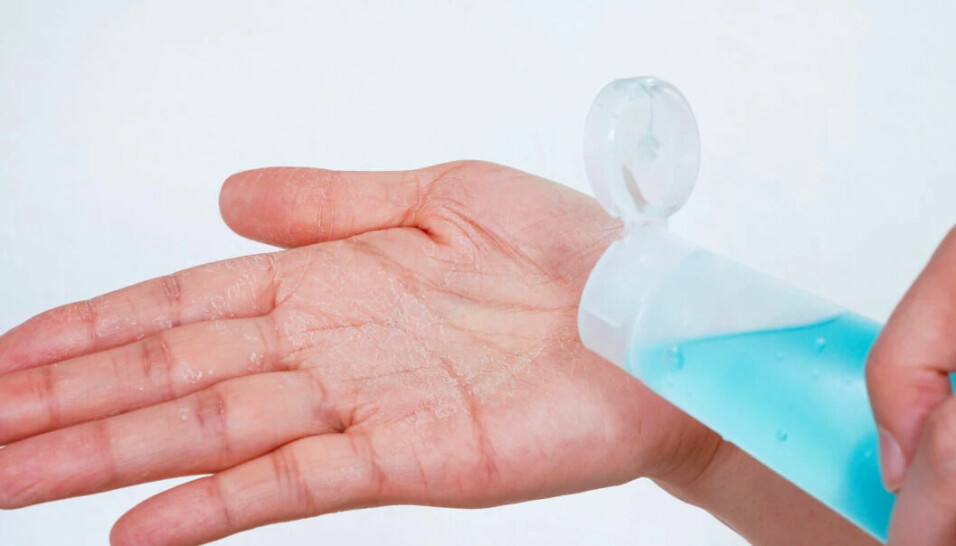
Covid-19 hygiene measures caused skin problems
They avoided the virus but damaged their skin. More hand washing and sanitising gave four out of ten healthcare workers greater problems with the skin on their hands.
They washed and sanitised their hands time and time again. They wore disposable gloves and masks for large parts of the working day.
When the coronavirus hit Norway, infection control suddenly became more important than ever. Not least for the employees at doctors' offices and hospitals.
Cracks and pimples
Results: Red, cracked, dry and flaky skin on the hands; acne and eczema on the face.
“We see a connection between the increased use of hand hygiene measures and increased eczema symptoms on hands. Increased use of a mask or respiratory protection also gave an increased risk of skin symptoms on the face,” Kaja Irgens-Hansen says.
She is an associate professor at the University of Bergen and senior physician at the Department of Occupational Medicine at Haukeland University Hospital. There, she has researched what the Covid hygiene measures led to in terms of side effects for the skin. Dagens Medisin (link in Norwegian) wrote about the study first.
Even before the pandemic, healthcare personnel suffered from skin disorders more often than others. One of the reasons is that they are exposed to a lot of moisture. It does not take more than half an hour of wet hands during a working day to increase the risk of eczema.

Washed hands more
During the Covid-19 pandemic, about twice as many people washed their hands more than 20 times a day or disinfected them more than 50 times a day. The use of moisturisers almost doubled as well. This is shown by the survey that Irgens-Hansen and her colleagues have carried out among 602 employees at hospitals and medical centres in the Bergen area.
All the washing and cleaning led to 42 per cent of those asked having increased symptoms on their hands, wrists, and forearms. The youngest were the worst affected.
Face masks
Face masks also led to skin problems. Of those who already had a skin disease before the pandemic, almost three out of four reported that their symptoms had worsened.
Those who have been affected the worst are those who suffer from pimples, but also those with open wounds and eczema. More than one in three respondents report symptoms of skin conditions on their faces.
Kaja Irgens-Hansen reckons that these skin conditions have affected more than just healthcare workers. She points out that most people, regardless of profession, were more concerned with hand hygiene during the pandemic.
“The study shows that cleaners and employees in hospital nurseries also had increased eczema symptoms on their hands. Like healthcare workers, these are occupational groups that are largely exposed to wet work,” she writes in an email to sciencenorway.no. “The general impression is that there was also an increase in symptoms of skin conditions on hands in the population during the pandemic.”

Known connection
Department director Karl-Christian Nordby at Stami, the State Department of the Working Environment, believes the same:
“It is well known that the use of soap and water causes several skin problems. The better we are at keeping our skin clean, the more eczema and dry skin we will get. When you wash your skin with soap and water, you get a kind of degreasing, so the impregnation disappears and more substances enter the subcutaneous tissue,” he explains.
He points to hairdressers as another occupational group with a lot of wet work, and tells us how cleaners had much more wet work during the pandemic:
“Today, a lot of what they do is mopping with a dry mop. It is electrostatically treated so that it attracts the dust. During the pandemic, there was a lot of ‘contagion washing’. For disinfection and to remove bacteria, soap and water are needed,” Nordby says.
We use less now
The researchers in Bergen have not been able to follow up their results after the strictest pandemic measures ended, since the survey was anonymous. Kaja Irgens-Hansen nevertheless believes that handwashing, and thus the symptoms, are back to old routines.
“We have received feedback that the purchase and consumption of hand hygiene products in our region is now considerably reduced compared to the first year of the pandemic,” she says.
———
Translated by Alette Bjordal Gjellesvik.
Read the Norwegian version of this article on forskning.no
References:
Vindenes et al. Changes in Infection Prevention Practices and Occurrence of Skin Symptoms among Healthcare Workers, Cleaners and Day-care Workers in Norway during the COVID-19 Pandemic, Acta Derm Venereol, 2023. DOI: 10.2340/actadv.v103.3420
Vindenes et al. Smittevern og hudutfordringer ved covid-19 (Infection prevention and skin challenges associated with Covid-19), Tidsskrift for Den norske legeforening, 2020. DOI: 10.4045/tidsskr.20.0365
































